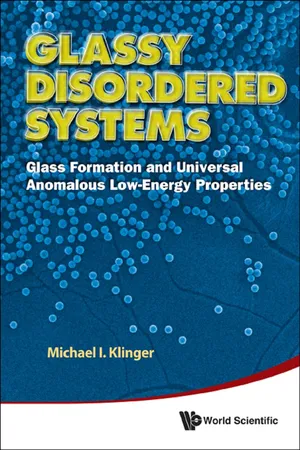The primary goal of the second part of the present book is to discuss a consistent description of the theoretical
soft-mode model, the nature of atomic-motion
soft modes and the role of the modes in anomalous properties of glasses, far below the liquid–glass transition. As seen in what follows, the properties (at least of a series of glasses) can be consistently described within the framework of this model, and some predictions can be made for experimental tests. The properties include the experimentally observed and studied dynamic and thermal properties of glasses at low frequencies
υ <<
υD and/or low temperatures
T <<
TD =
hυD/
kB ≡
hυD, where
υD and
TD are the effective Debye frequency and temperature respectively (as well as in part A, in what follows the Boltzmann constant
kB = 1). These properties are often referred to as anomalous properties in the sense that they are not characteristic of the crystalline counterparts. The most widely known anomalous properties of glasses appear to be the
T - and
T2 temperature dependence of specific heat and thermal conductivity respectively at very low temperatures,
discovered by Zeller and Pohl in 1971 [
104], and the so-called “boson peak”, a broad asymmetric peak in photon or neutron inelastic scattering intensity at a moderately low frequency shift (below referred to as frequency)
υ =
υBP ≈ 1 THz, which is not characteristic of crystals. Since that time, the anomalous properties of glasses have been investigated in numerous works (e.g., [
105,
106,
107,
109,
110,
111,
112]) and are referred to as universal properties in the sense that they are also weakly sensitive to differences in chemical composition and local atomic structures of the materials. Let us emphasize that the above
does not contradict the experimental fact that in a few crystals, e.g., in the cristobalite polymorph of S
iO
2, a peak is also observed in the reduced inelastic neutron scattering intensity, i.e. in the reduced vibrational density of states [
7], at a noticeably higher
υ =
υp, e.g., at
υBP, which can be sometimes related to the lowest van Hove singularity of the crystal [
113]. This and other differences between low-energy properties of glasses and those of respective crystals show that the anomalous properties under discussion in what follows characterize glassy, amorphous systems, rather than crystals. In other words, the amorphous, glassy state of the system in general appears to be a necessary condition for the boson peak existence.
Taking into account the above-mentioned primary goal and, on the other hand, the very large number of investigations of the anomalous dynamic and thermal properties of glasses, the present review also describes, for comparison, other (not explicitly related to the soft-mode model) recent theoretical models of the glassy properties. The soft-mode model appears to be the only model that is able to describe, qualitatively and in scale at least, the glassy properties at both very low and moderately low frequencies and temperatures. In the section below, we concentrate on the soft-mode model and anomalous, universal properties of nonmetallic (insulating and semiconducting) glasses, for which the role of electronic excitations and their interaction with other excitations are not so important (for metallic glasses the properties are considered in detail in a number of reviews, in particular, in [8, 9]).




